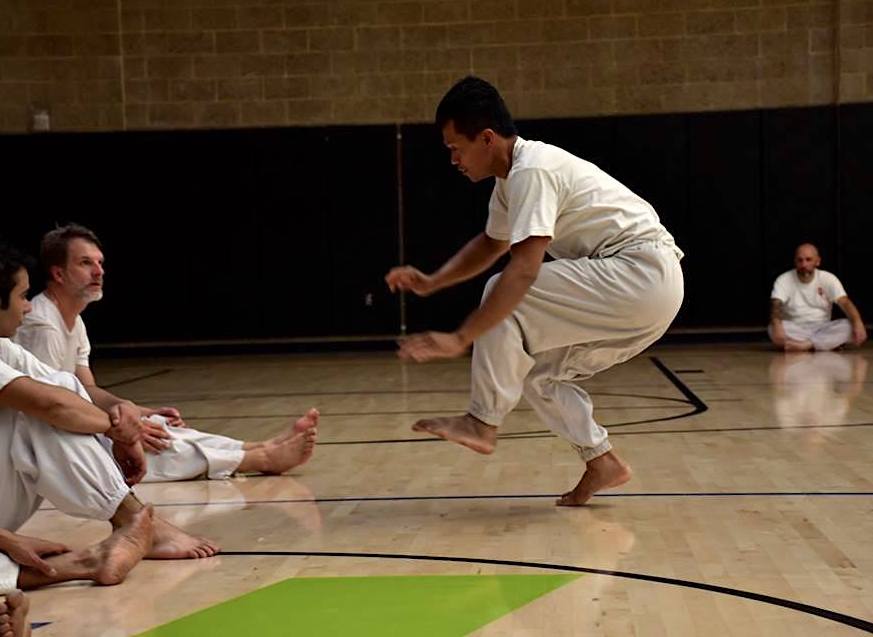
Glossary
- ambil/ambilan:
- to take; a throw, takedown
- badan:
- body
- bangau:
- crane
- besar:
- big, large, great
- beset/besetan:
- lit. scrape off or flay; a sweeping throw
- besi:
- (“beh-SEE”) iron
- buka:
- open, start (e.g., open the latihan)
- bulan:
- moon, month
- cabang:
- branch group of PGB
- cukup:
- enough, sufficient, adequate
- dasar:
- basic
- ganti:
- change, substitute, replace (i.e., change sides right to left; change partners)
- gerak/gerakan:
- to move; a movement
- gerak pendek/gerak panjang:
- short move, long move
- gerak teknik:
- movement techniques or applications
- guru/Guru Besar:
- teacher; Great Teacher or Grandmaster
- ilmu/keilmuan:
- science, knowledge; The Science (of WCS)
- jalan:
- path or way
- jalan panjang, jalan pendek:
- long way, short way
- jatuh/jatuhan:
- to fall or drop; a falling technique
- kaki:
- foot/leg
- kanan:
- right
- keterampilan:
- tumbling or acrobatics (lit. “skills”)
- kiri:
- left
- lagi:
- again!, repeat
- latih/latihan:
- exercise, practice, train; training session
- lingkaran:
- a circle
- Malam:
- Bulan Purnama Full Moon Night (see Peh Gwe Cap Go below)
- masuk:
- enter
- muda:
- young, light or pale, unripe
- orang:
- person
- pelatih:
- trainer
- pencak:
- silat system of self-defense (usually refers to indigenous Malay or Indonesian martial arts)
- pukul/pukulan:
- memukul hit/punch; a punch; to hit
- pusat:
- center, headquarters (the PGB Pusat is located in Bogor, Indonesia)
- sabuk:
- belt, sash (martial art belts indicate training level by color)
- sehat/kesehatan:
- healthy; health
- silat/pesilat:
- self-defense; silat practitioner, martial artist
- stagen:
- long sash or cummerbund (wrapped tightly around hip area to stabilize lower back and organs)
- sumpah:
- oath
- tahun:
- year
- tangan:
- hand
- tangkis:
- parry
- TC:
- (“tay-say”) Training Center
- tendangan:
- a kick
- terus:
- continue, go on
- tiga:
- per empat ¾ stance
- tua:
- old, dark, ripe
- tutup:
- close, end (e.g., close the latihan)
Commonly used terms
- 1.
- Satu
- 2.
- Dua
- 3.
- Tiga
- 4.
- Empat
- 5.
- Lima
- 6.
- Enam
- 7.
- Tuju
- 8.
- Delapan
- 9.
- Sembilan
- 10.
- Sepuluh
Numbers
- bhesi or beesi (“BAY-see”):
- basic front stance
- bhesi tai ma:
- horse stance
- kwan "gate":
- a portion of a long movement practiced on its own, essence of a long move
- Kwan Yin:
- Goddess of Compassion (also refers to a system of movement)
- liong bun:
- lit. “dragon gate”: choreographed fighting combinations, special self-defense techniques
- Lohan / luohan:
- refers to movements in the Arhat/Bodhisattva system
- pa hong:
- punching
- Peh Gwe Cap Go:
- name of the Chinese Harvest or Full Moon ceremony, conducted at the full moon of the 8th lunar month to honor the school, the science, and the lineage of PGB
- soja:
- gesture with palms pressed together at chest height
- Suhu:
- honorific term applied only to grandmasters of self-defense and healing
- su kong:
- forearm bashing exercise (to train nerves to withstand impact)
- tek giok:
- cross-legged or twisting stance
- Tao Kung:
- the way of subtle energy, PGB’s health movement system
- tie ka ciu:
- a grasp and pull technique
- tui cu (“twee choo”):
- “exchanging sweat,” sparring
- yang:
- often denotes ‘same’ side; can also refer to ‘hard’ style movements or methods of training focused on developing external energy
- yin:
- often denotes ‘opposite’ side; can also refer to ‘soft’ style movements or methods of training focused on developing internal energy